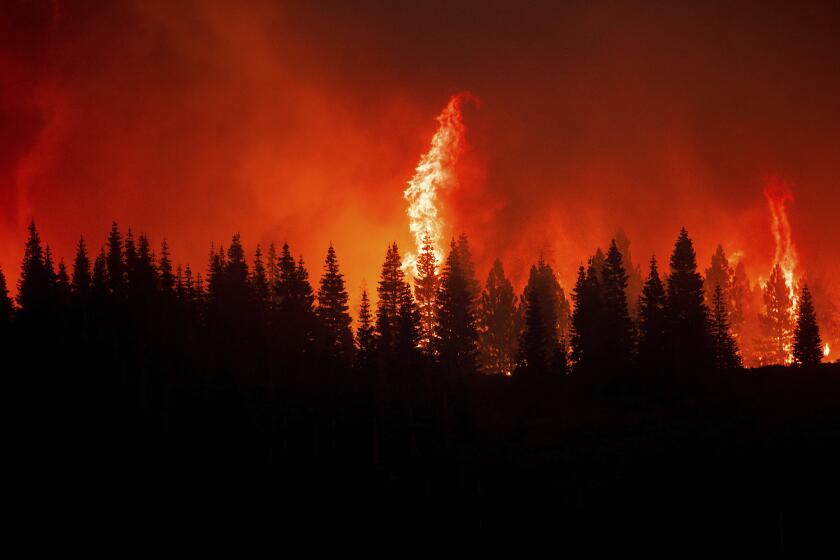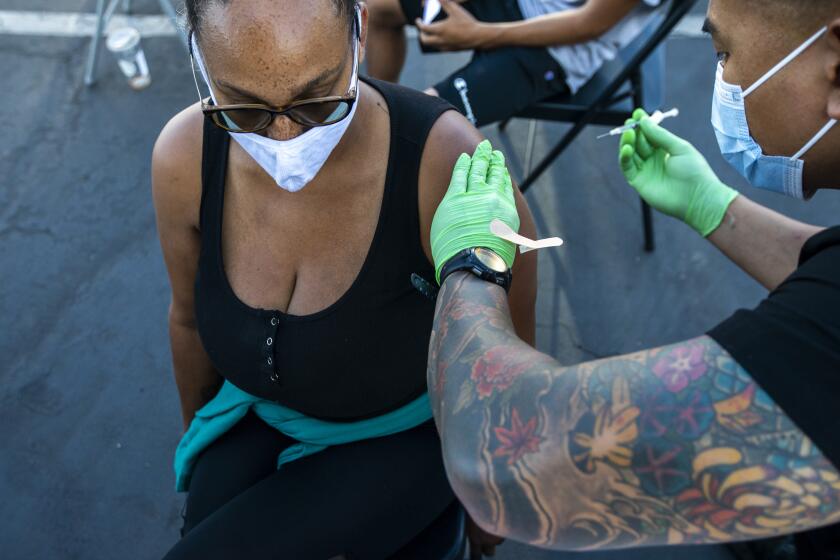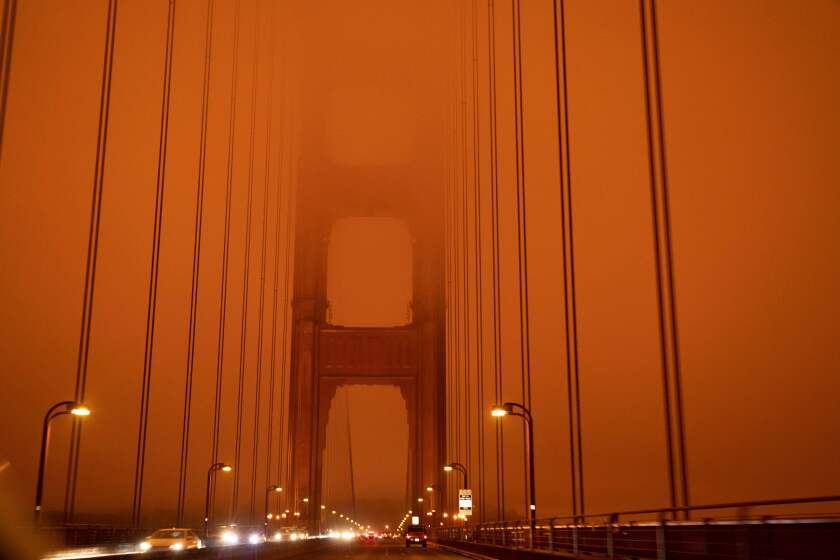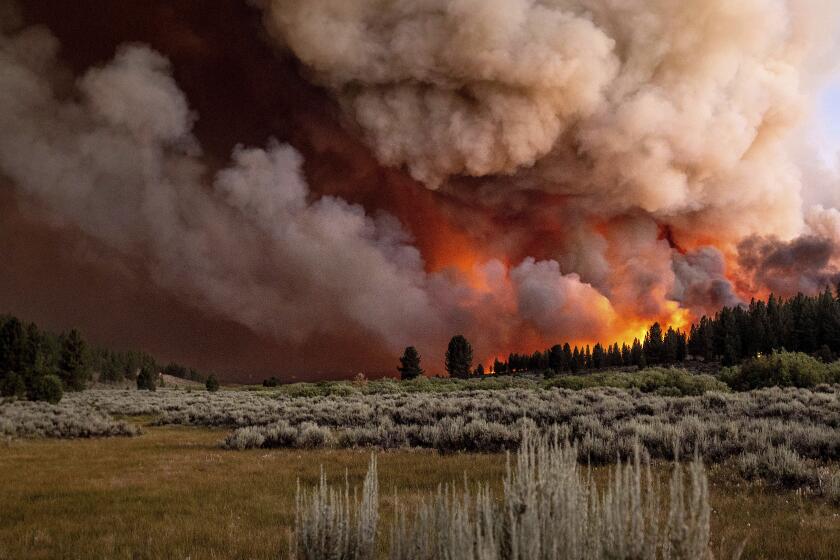With metals and maybe even coronavirus, wildfire smoke is more dangerous than you think
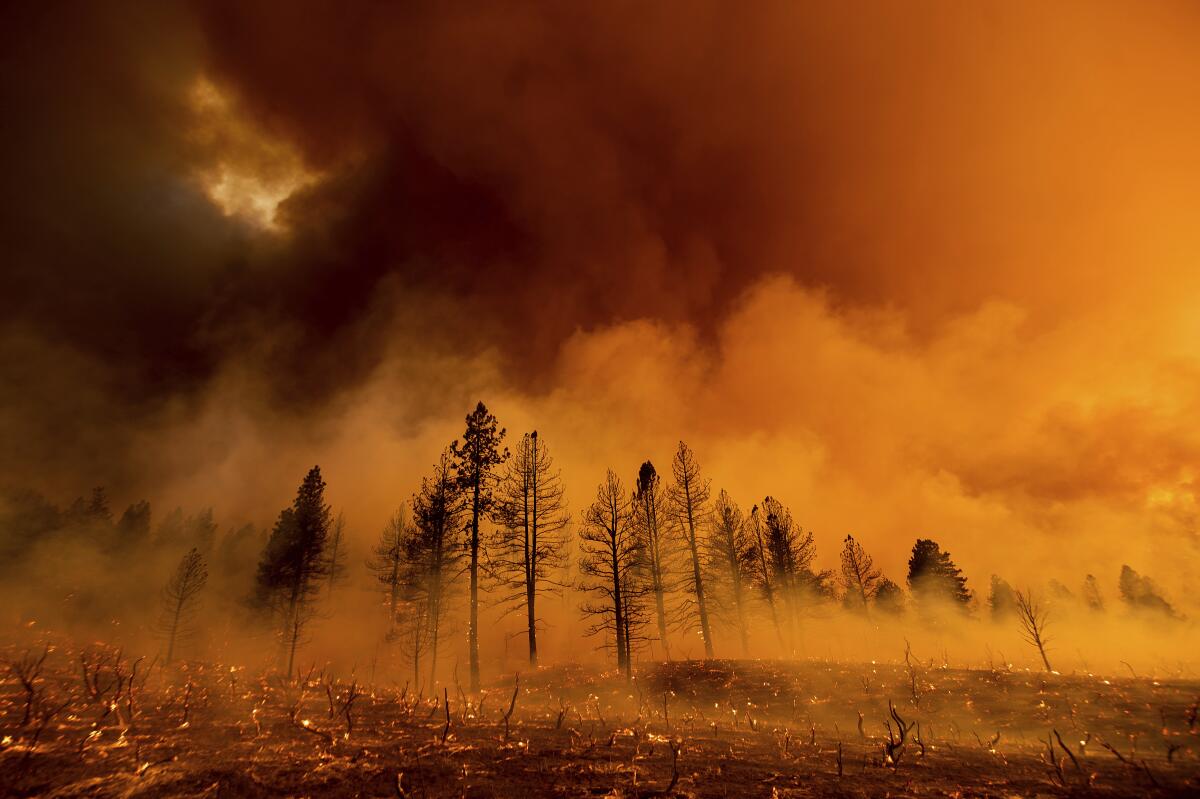
- Share via
When Erin Babnik awoke on the morning of Nov. 8, 2018, in Paradise, Calif., she thought the reddish glow outside was a hazy sunrise.
But the faint light soon gave way to darkness as smoke from the burgeoning Camp fire rolled in.
“The whole sky turned completely black, and there were embers flying around,” Babnik recalled. “I remember it smelling horrible.”
She hastily evacuated to nearby Chico with little more than an overnight bag. Her rented home, along with nearly every other structure in Paradise, would soon be reduced to ash.
Although several years have passed and thousands of additional wildfires have ignited across California, researchers are still unpacking the precise dangers of smoke from blazes like the Camp fire. Already this year, plumes from Western fires are making their way across much of the U.S. and Canada.
One recent study found that smoke from the Camp fire was particularly noxious because it contained particulates from burned homes as well as vegetation — something officials fear will become more common as home-building pushes farther into the state’s wildlands.
Another study linked wildfire smoke to an increased risk of contracting COVID-19.
The findings indicate that as fire season ramps up, the dangers of respiratory illness and other serious side effects from smoke loom nearly as large as the flames.
Already this year, there have been more than twice as many acres burned than during the same period last year — and hundreds more fires.
The 2018 Camp fire was the deadliest wildfire on record in California. At least 85 people died, and nearly 19,000 buildings were destroyed, mostly in Paradise.
The fire also generated a massive plume of heavy smoke that spewed dangerously high levels of pollution into the air for about two weeks, according to a study released this month by the California Air Resources Board.
Researchers examined data from air filters and toxic monitors to determine that smoke from the fire was in many ways more harmful than that of three other large fires that burned mostly vegetation that year — the Carr fire, the Mendocino Complex fire and the Ferguson fire.
Elevated levels of chemicals such as lead, zinc and iron generated by smoke from the Camp fire were detected in nearby Chico and as far away as San Jose and Modesto, the study found.
The lead was of particular concern because it has well-documented health impacts on blood pressure and reproductive systems and has been strongly linked to cancer and neurological disorders, especially in children, said Michael Benjamin, chief of the Air Quality Planning and Science Division at the California Air Resources Board.
“There are very good reasons why we try to keep lead out of the air,” Benjamin said, noting that federal and state governments already have taken actions to protect people against the chemical, such as banning lead paint and leaded gasoline.
Many of the buildings razed in the Camp fire were likely constructed before the 1978 lead paint ban, Benjamin said. And many of the vehicles that burned likely contained chemicals such as zinc.
“When we have an incident like this, where you have 19,000 structures that burned in Paradise … all of those metals are vaporized and released into the atmosphere,” he said.
Lead levels in Chico, the closest available monitoring site to the Camp fire, were 50 times higher than normal for one 24-hour period during the fire, Benjamin said.
The study results didn’t surprise David Little, who was editor of the Chico Enterprise-Record when the fire broke out and now serves as executive vice president of communications at the North Valley Community Foundation, which provides relief and recovery efforts for Camp fire victims.
“We have fires here every year, but this was something spectacular and different,” Little said of the Camp fire’s smoke. “It was like this curtain coming down. It went from blue sky to black, like someone turned out the lights.”
And the smoke wasn’t like what billows from a regular forest fire or brush fire, he said. It was more akin to a tire fire, where “black stuff comes out of the air and lands on you.”
“That’s what our whole county was enveloped in for many, many days,” he said.
The air board’s Benjamin said researchers have not yet tracked specific health impacts on residents who lived through the Camp fire, but he noted that millions of people in Northern California were exposed to brief but elevated lead levels during its wrath.
Researchers are, however, beginning to examine the “negative synergy” between wildfire smoke and COVID-19, he said, noting that the coronavirus can “compromise people’s respiratory systems and make people more susceptible to the impacts of particulate and smoke.”
Tuesday marked the fifth straight day that the number of new coronavirus infections exceeded 1,000.
At least one group of scientists at the Desert Research Institute in Nevada already has found a correlation.
A study published this month in the Journal of Exposure Science and Environmental Epidemiology found that wildfire smoke may greatly increase susceptibility to COVID-19.
Researchers focused on about 36,000 patients at a hospital in Reno between Aug. 16 and Oct. 10, 2020 — the period most affected by smoke from Western fires like the August Complex, the Creek fire and the Glass fire — and found that an increase in particulate matter from wildfire smoke was associated with a nearly 18% increase in the number of coronavirus cases.
The findings are “important to be aware of as we are already confronting heavy wildfire smoke from the Beckwourth Complex fire and with COVID-19 cases again rising in Nevada and other parts of the Western U.S.,” said Daniel Kiser, an assistant research scientist at DRI and one of the study’s coauthors.
The study controlled for variables such as the general prevalence of the virus and the number of tests administered. Scientists said the findings likely can be extrapolated to other areas affected by fires.
There are no definitive answers about how wildfire smoke and COVID-19 are linked, said Gai Elhanan, a health data scientist at DRI and another of the study’s coauthors. One possibility is that exposure to smoke is altering peoples’ immune response, while another is that the smoke creates an overexpression of ACE2 respiratory cells. A third is that the coronavirus’ particles may attach themselves to smoke particles, making people more susceptible to ingestion of the pathogen.
The effects of wildfire smoke also depends on what’s burning, Elhanan said.
“This is part of the complexity of what we inhale,” he said.
Researchers are analyzing what microbes exist in the smoke and dust produced during wildfires.
Neither study is the first to examine the harmful impacts of wildfire smoke: Last year, researchers found it contains fungi, bacteria and other airborne pathogens. But the latest findings add to a growing list of evidence about its dangers.
And as wildfires become larger, more frequent and move closer to communities, experts said it is increasingly important for people to be aware of what the blazes are belching.
“You’re not only now burning wood,” said Peter DeCarlo, an associate professor of environmental health and engineering at Johns Hopkins University. “You’re burning heavy metals, and you’re burning plastics and other things that wouldn’t burn just in a forest fire. … Those add additional chemicals, many of which we know are toxic and noxious, to what’s already bad from wildfire smoke.”
And thanks to extremely parched vegetation, fires also are burning hotter and with greater intensity, which can enable smoke to travel farther, he said.
“How intense the fire is burning determines how high in the atmosphere [the smoke] gets,” DeCarlo said. “The higher it gets in the atmosphere, the easier it is to transport long distances.”
Satellite imagery from 2018 showed the massive smoke plume from the Camp fire swirling over California, while smoke from fires in 2020 traveled as far as Europe.
Residents in the path of wildfires aren’t the only ones facing respiratory issues from smoke, as firefighters spend hours and sometimes days in their fumes.
Many firefighters who worked the Camp fire, Carr fire and 2017 fires in Santa Rosa finished those assignments with some type of respiratory infection or ailment, said Brian Rice, president of the California Professional Firefighters labor union.
“There’s no question that our members get a major exposure to toxins. Whether they’re metals or benzines or polyfluor carbonates, we get them,” he said. “It’s known, it’s there. It’s killing us.”
The problem is becoming more common as firefighters increasingly tackle blazes where the built environment meets the natural one, Rice said. Respirator technology that works well for urban structure fires doesn’t translate easily into wildland areas, where crews often are working in remote, high-altitude terrain and carrying supplies on their backs.
A firefighter in those conditions can burn through a 30-minute supply of clean air in 10 minutes, he said.
“We know the products of combustion that are known carcinogens are in that smoke,” Rice said, noting that fumes from burning cars, homes and even pesticide-sprayed agriculture can harm fire crews. “And when you are working under stress, you breathe harder.”
Already this year, there have been more than twice as many acres burned than during the same period last year — and hundreds more fires.
As fire season in California is starting earlier and running longer, researchers from both studies said smoke is becoming increasingly inevitable, so protection against its exposure should be a top priority.
One important step is making sure people have a supply of N95 masks — particularly those in disadvantaged or underserved communities. Cloth masks worn for COVID-19 protection don’t work as well against wildfire smoke particles, which are about 30 times smaller than a strand of human hair, researchers said. N95 masks are more effective against both the virus and smoke, according to the California Department of Public Health.
Smoke relief centers can also help mitigate exposure.
Though it’s difficult to determine whether one person’s sickness — be it COVID-19, asthma or another respiratory issue — is definitively linked to one particular fire, Benjamin said, wildfire smoke of any kind is most certainly a danger.
When it comes to particulate matter, “the nose is a good early warning system,” he said. “And if people smell smoke, they should assume they are being exposed.”
More to Read
Sign up for Essential California
The most important California stories and recommendations in your inbox every morning.
You may occasionally receive promotional content from the Los Angeles Times.
